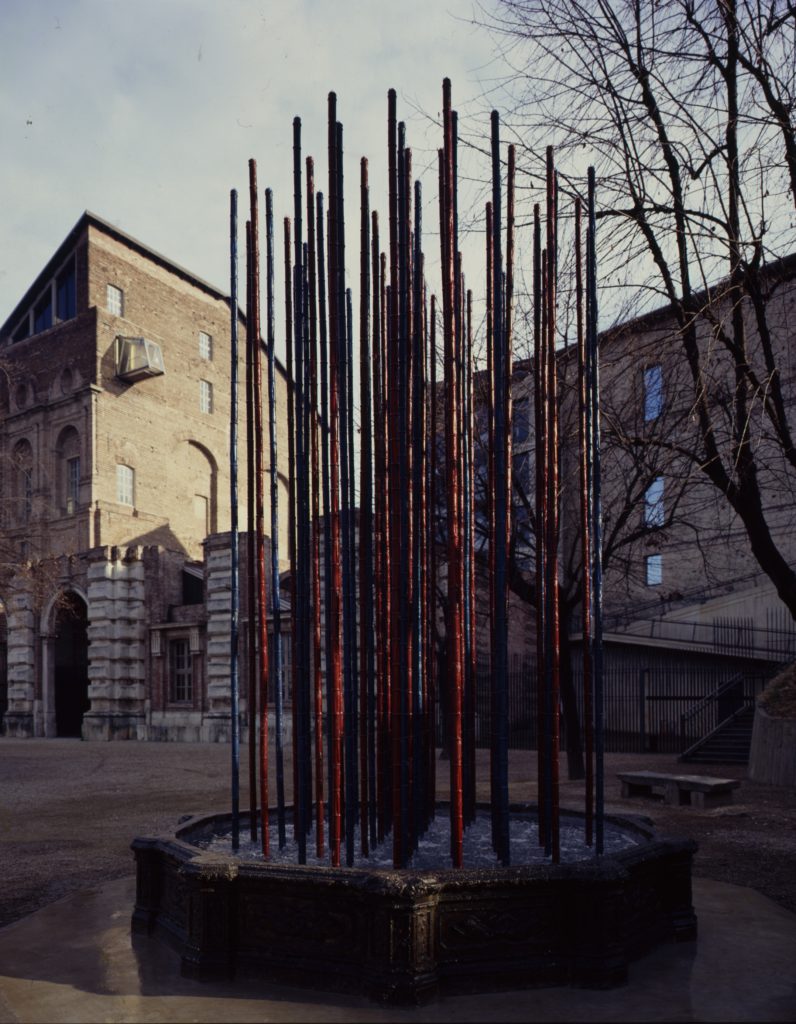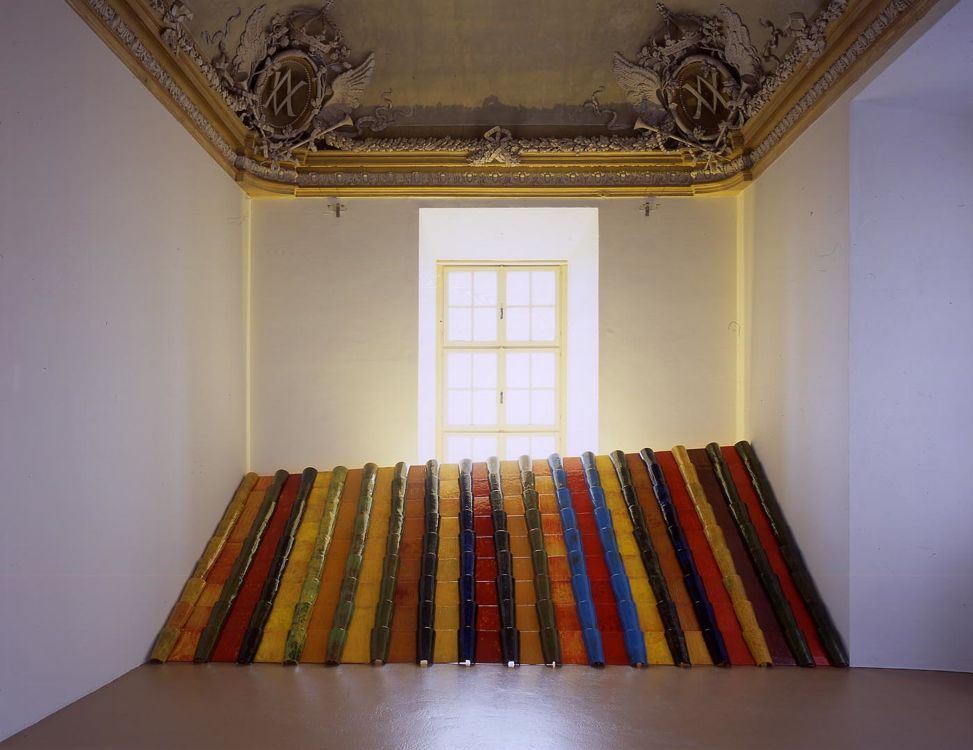Marco Bagnoli
“I am developing experiences, the result of which might be an accurate picture in which past and future end up on the same level,” Marco Bagnoli commented on the occasion of a solo exhibition of his work held in the early 1980s. Since the 1970s, Bagnoli has charted an original path, in which he arranges conditions for abandoning the dualistic opposition between intuitive and rational thought. In so doing, the artist intentionally looks back to the Italian Renaissance, to a cultural tradition in which philosophy and science were integral to the figure of the artist.
Engaged in continuous study and travel, Bagnoli delves into the numerous areas that make up his cultural references, drawing on Islamic culture, the mystical poetry of the Persian writer Rumi, Sufism, and the doctrines of Hinduism and Taoism for his work. Mirabile verso di là dall’atmosfera (Wondrous Verse Beyond the Atmosphere), 1986, is part of this artistic journey, and is intended to underline convergences of and dissonances between the mysteries of early Eastern and Western cultures. A lyrical vision of an outdoor landscape, the installation proposes a possible break with the architectural definition of interior space, through the view of roof tiles struck by lightning. The sudden discharge of energy and the manifestation of light are rendered as a succession of polychrome tiles in enameled ceramic. In a commentary in the I Ching, or Book of Changes, the Chinese sacred text, just as silence is the opposite of the word, lightning is defined as the supreme state of non-being, of total possibility and indeterminateness, capable of revealing the heart of the universe.
Bagnoli’s art strives to uncover the essence of things, and in his works form and meaning are intimately and necessarily linked. The installation La Parola (come la Colonna ogni parola nel silenzio una colonna) (The Word—like the Column every word in the silence a column), 1991, consists of a large cubic installation, whose height is above eye level. Imposing and labyrinthine, the work reveals something of itself through ten openings arranged along three sides. In each of these openings, the alternation of light and darkness discloses the presence of columns and narrow corridors; the fourth side is a solid wall. The impossibility of seeing the work from above, and therefore of being able to completely comprehend it intellectually, corresponds to the form dictated by its existence in the museum space. The structure corresponds to the sculptural interpretation of the Kufic script of the “word,” the ancient Arabic term that describes the divine and therefore must not be spoken. A search for the absolute is also one of the themes of the installation made up of Colui che sta (He Who Is) and Benché sia notte (Though It Be Night), both from 1991–92, which Bagnoli created specifically for his solo exhibition at the Castello di Rivoli. In the first work, the various rotations of a series of wooden disks create a sculpture whose shadow projects a double human profile. The title is derived from the Vedic figure of Sthanu, the deity who, according to mythology, was transformed into a pillar of fire surrounded by the continuous emanation and disappearance of multiple figures, evocations of those mortal beings that he refused to create. Like a two-headed creature, capable of seeing in opposite directions, the work suggests the possibility of overcoming the dualistic limitations of reason. The second work consists of a loosely woven grid of copper strips, on which are placed small boxwood roots. Like a niche for the other statue, Benché sia notte plots out a space of reference in which the viewer can orient him- or herself, like in a starry vault. Light plays a fundamental role in all of Bagnoli’s work. In Porte regali (Royal Doors), 1992, the artist uses alabaster to create a large, luminous door-like structure. The material’s transparency allows light to filter in, a possible emanation from an otherwise inaccessible dimension. The concept according to which the work is an ideal channel is emphasized by another element, present in many of Bagnoli’s creations: a vertical red band, “the vermilion field” that defines the center of the structure. The title of the work refers to an essay by Pavel Florenskij on the painting of medieval Russian icons and their function as a threshold between the visible world and the invisible world of divinity. During the course of his investigations, Bagnoli has often focused on places outside the traditional museum spaces. Working with the relics of an ancient fountain placed outside the Castello building, he designed Cinquantasei nomi (Fifty-Six Names), 1999–2000. The work is made up of fifty-six aluminum rods, shaped like bamboo, but painted blue and red. Their arrangement follows the “quincunx,” the configuration of staggered parallel rows used in arboriculture. Adopted in the West since ancient Roman times, the quincunx can also be found in the East, particularly in Tibetan mysticism, as a central element from which the mandala develops.
[MB]





